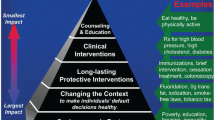Abstract
Genuine community engagement is critical to the success of hospital-based injury and violence prevention (HIVP) programs. Affecting sustainable community level reductions in injuries requires implementation of injury prevention strategies “with” a community rather than merely “in” a community. These partnerships are often strategically identified through a combination of institution-specific factors like trauma registry data, participation in local or regional injury prevention community coalitions, a hospital’s Community Health Needs Assessment (CHNA) or population health priorities, existing partnerships developed through a hospital community relations department, and city or county-wide health and safety initiatives. The purpose of this chapter is to offer effective strategies for trauma centers and HIVP professionals to identify and prioritize communities or populations for injury prevention partnerships, develop sustainable and genuine partnership, and engage in the shared development, implementation, and evaluation of the injury prevention intervention.
Access this chapter
Tax calculation will be finalised at checkout
Purchases are for personal use only
Similar content being viewed by others
References
Glanz K, Rimer BK, Viswanath K, editors. Health behavior: theory, research, and practice. 5th ed. San Francisco, CA: Jossey-Bass & Pfeiffer Imprints, Wiley; 2015. 1 p. (Jossey-bass public health).
Green LW, Mercer SL. Can public health researchers and agencies reconcile the push from funding bodies and the pull from communities? Am J Public Health. 2001;91(12):1926–9.
Swahn M, Hankin A, Houry D. Addressing injuries in vulnerable populations: research collaborations and partnerships. West J Emerg Med. 2012;13(3):215–6.
Moore M, Conrick KM, Fuentes M, Rowhani-Rahbar A, Graves JM, Patil D, et al. Research on injury disparities: a scoping review. Health Equity. 2019;3(1):504–11.
The National Center for Fatality Review and Prevention. Child death review [Internet]. [cited 2022 Apr 20]. Available from https://ncfrp.org/cdr/
Clinical and Translational Science Awards Consortium, United States, National Institutes of Health (U.S.), Centers for Disease Control and Prevention (U.S.), United States, editors. Principles of community engagement. 2nd ed. Washington, DC: Department of Health and Human Services, National Institutes of Health, Centers for Disease Control and Prevention, Agency for Toxic Substances and Disease Registry, Clinical and Translational Science Awards; 2011. 193 p. (NIH Publication).
Janosky JE, Armoutliev EM, Benipal A, Kingsbury D, Teller JLS, Snyder KL, et al. Coalitions for impacting the health of a community: the Summit County, Ohio, experience. Popul Health Manag. 2013;16(4):246–54.
Prevention Institute. Developing effective coalitions: an eight step guide [Internet]. [cited 2022 Aug 15]. Available from https://www.preventioninstitute.org/publications/developing-effective-coalitions-an-eight-step-guide
Rosenblatt MS, Joseph KT, Dechert T, Duncan TK, Joseph DK, Stewart RM, et al. American Association for the Surgery of Trauma Prevention Committee topical update: impact of community violence exposure, intimate partner violence, hospital-based violence intervention, building community coalitions and injury prevention program evaluation. J Trauma Acute Care Surg. 2019;87(2):456–62.
Gilmer TP, Center K, Casteel D, Choi K, Innes-Gomberg D, Lansing AE. Developing trauma resilient communities through community capacity-building. BMC Public Health. 2021;21(1):1681.
Centers for Disease Control and Prevention. Principles of community engagement. 2nd ed. [Internet]. 2011. [cited 2022 Aug 18]. Available from https://www.atsdr.cdc.gov/communityengagement/index.html
Porter DM, Miller BK, Mullins SH, Porter ME, Aitken ME. Is a driver’s license age waiver worth a teen’s life? Inj Epidemiol. 2018;5(S1):8.
Collins JW. Achieving engagement in injury and violence prevention research. Inj Prev. 2019;25(5):472–5.
Racher FE, Annis RC. Respecting culture and honoring diversity in community practice. Res Theory Nurs Pract. 2007;21(4):255–70.
Hanson D, Hanson J, Vardon P, McFarlane K, Lloyd J, Muller R, et al. The injury iceberg: an ecological approach to planning sustainable community safety interventions. Health Promot J Austr. 2005;16(1):5–10.
Author information
Authors and Affiliations
Corresponding author
Editor information
Editors and Affiliations
Rights and permissions
Copyright information
© 2023 Springer Nature Switzerland AG
About this chapter
Cite this chapter
Porter, D., Miller, B., Adams, C. (2023). Building Injury Prevention Capacity Through Community Partnership. In: Adams, C., Tinkoff, G. (eds) Hospital-based Injury and Violence Prevention Programs. Springer, Cham. https://doi.org/10.1007/978-3-031-20357-2_4
Download citation
DOI: https://doi.org/10.1007/978-3-031-20357-2_4
Published:
Publisher Name: Springer, Cham
Print ISBN: 978-3-031-20356-5
Online ISBN: 978-3-031-20357-2
eBook Packages: MedicineMedicine (R0)




